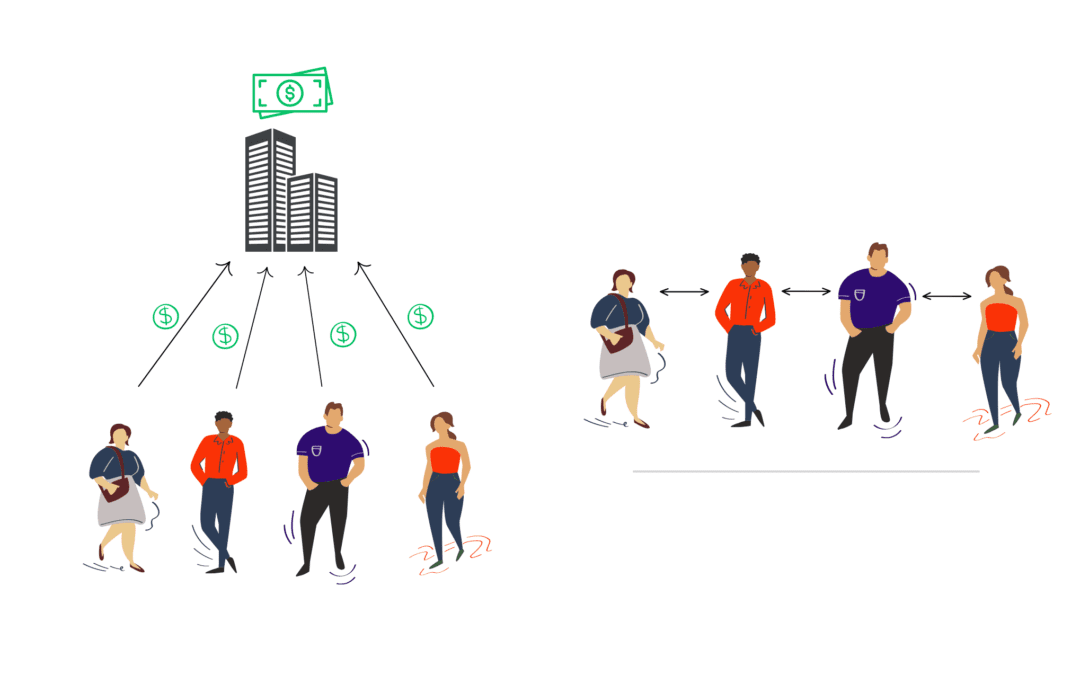Over the past decade, growing pressure on companies to reduce their environmental impact and the rise of digital platforms have contributed to the development of a new economic model. Similar to bartering adapted to today’s tastes, this economic model offers numerous benefits for the environment and society. I call it: the collaborative economy.
What is the collaborative economy?
The collaborative economy, sharing economy or “sharing economy” encompasses all exchanges, whether monetary or non-monetary, that are based on sharing, collaboration and mutualization rather than sale, possession or private ownership. Exchanges of goods, services, resources, time and knowledge are all examples of the collaborative economy.
Why the collaborative economy matters?
The aim of the collaborative economy is to promote peer-to-peer exchanges, minimize the number of intermediaries and value use over single possession. The collaborative economy is advantageous for both parties. On the one hand, limiting the number of intermediaries and sharing costs between several parties reduces costs for the consumer. On the other hand, the supplier has more direct access to his market.

In addition to benefiting the parties involved in the exchange, the collaborative economy is often beneficial to the environment and society. Indeed, this economic model makes it possible to reduce the consumption of new goods, which in turn reduces pressure on ecosystems and natural resources. It also means that goods are used throughout their lifetime, rather than being left to rot in a closet. For example, did you know that we buy drills and use them for an average of… 12 minutes? How many such objects do we own, when a loan model would make more sense, both for our wallets and for our planet?
What’s more, the horizontal hierarchy of the collaborative economy puts all individuals on an equal footing. So, to replace a model where all consumers pay companies to buy new goods or services, the collaborative economy advocates exchanges between individuals or via SMEs specialized in sharing goods.
Types of Collaborative Economy
The collaborative economy thrives when a community has complementary needs or common interests and when there is a centralized point, such as a group on social networks, a mobile app, a website, or other means of gathering. Two types of collaborative economy are very popular around the world:
- Transport-sharing platforms (carpooling, travel services and car or bicycle sharing). For example, the car-sharing application Communauto (Montreal, Toronto, Quebec City, Sherbrooke, Victoriaville…) is transforming our use of cars by focusing on their use, rather than their ownership. As a result, many cars have been taken off the road, and this model not only helps reduce congestion on the roads, but also cuts carbon emissions (over the life cycle, thanks to reduced traffic jams, etc.);
- Room or accommodation rental platforms, such as AirBnb.
As for Canada, the collaborative economy is everywhere! Here are just a few examples:


- Book boxes. Installed in many neighbourhoods, book boxes are small outdoor libraries where you can pick up a book for free and drop off books you have at home for someone else to read.
- Community grocery stores. Although rarer than book boxes, there are community grocery stores just about everywhere in Canada. In these stores, you can become a member and give a few hours of your time each week in exchange for great discounts on food.
- Community gardens. In Montreal, for example, you can cultivate vegetable gardens managed by the city, at lower cost and with associated shared services (land, water access, tool shed or box…).
- Accorderies and community service exchange banks (BECS). These are local networks where members exchange time, services, talents and sometimes goods rather than money.
- Numerous associations. Associations are a goldmine for the collaborative economy. Often driven by common interests, people are ready to donate their time, skills, resources and tools in exchange for practicing their sport, game or art at a lower cost, depending on the nature of the association.
- The PartageClub mobile app. Based on an annual subscription, you are put in touch with your neighbours to exchange your objects rather than buying new ones and breaking your piggy bank!
Sustainable Communities: a collaborative economy
Will Solutions, a specialist in the production and sale of carbon credits, contributes to the collaborative economy in two ways. Firstly, Will Solutions’ structure is part of a collaborative economy model. Secondly, Will Solutions finances projects linked to the collaborative economy.
Sustainable Communities: a structure based on sharing
Let’s take car-sharing platforms like Turo as a comparison. The concept of such platforms is based on the fact that owning a car is expensive, and that cars are unused 95% of the time in Canada! As a result, the platforms bring together cars available for use and people interested in using them, which benefits both parties.
On the one hand, car owners who want to share their cars are in greater demand thanks to the platform, which is more attractive thanks to its volume of available vehicles: a car owner won’t rent out his car as easily if he has his own site as if there is a grouping of owners like him on the same platform. What’s more, the sum of all the uses to which a car is put in a year repays some or all of the annual costs associated with that car. On the other hand, rather than paying thousands of dollars a year for the payments, maintenance and insurance of a personal car, users borrow cars by paying per subscription or per use. It’s a win-win situation.


Will Solutions acts as a rallying point in the same way as car-sharing platforms. Here, the Will Solutions concept is based, on the one hand, on the fact that small emitters (SMEs, institutions, NPOs, etc.) who implement projects to reduce their greenhouse gas emissions would not be able to access carbon revenues on their own.
Indeed, access to the voluntary carbon market (VCM) involves tens of thousands of dollars of investment to register a project and verify it annually, not to mention countless hours of work. On the other hand, many large companies are looking to offset their greenhouse gas emissions by purchasing carbon credits. To kill two birds with one stone, Will Solutions brings together buyers of carbon credits and hundreds of members who have implemented one or more greenhouse gas reduction projects, and connects these complementary players in the market.
Members of the Sustainable Communities (Will Solutions’ collaborative project hub) are like car owners who want to share: rather than each submitting their reduction projects to standards such as VCS or Gold Standard, members join the Sustainable Community. By grouping all members’ projects together in the Community, the costs associated with accessing the voluntary carbon market, where carbon credits are sold, are completely eliminated.
Purchasers of carbon credits are like car users: through Will Solutions, they have access to a portfolio of local, community-based, high-quality carbon credits to offset their emissions. In this way, they help finance greenhouse gas reduction projects arising from the collaborative economy. So, once again, it’s a win-win situation. If you’re interested in Will Solutions’ collaborative economy principle, you can find out more on our page dedicated to our unique business model!
Financing collaborative economy projects
A number of Sustainable Communities members have adopted the principle of the collaborative economy in implementing their projects: residual materials from one company can be used as raw materials for another.


For example, one of our members, instead of paying to landfill waste glass, sells it to other companies for use in their processes, such as the production of reflective paint. For these companies, the cost of acquiring materials is greatly reduced. In short, working sustainably can sometimes save time and money, if you think outside the box!
Will Solutions encourages and financially rewards waste optimization projects (among others), as they reduce the greenhouse gas emissions associated with landfilling materials and the production of raw materials. If you have a waste-to-energy project, or would like to learn more about this type of project, contact us!
Sharing: key to the economy of the future?
Admittedly, the collaborative economy can’t meet every need at the moment. However, it is a promising alternative economic system in the context of the environmental and social crisis. It’s a major paradigm shift. The emphasis on sharing and use rather than individual possession slows the race to consume and relieves pressure on ecosystems.
We therefore believe that the values of sharing, cooperation and climate action, which are conveyed by the collaborative economy and Will Solutions, will increasingly come to the fore.
Are you ready to be part of the change?
Authors and editors of the article


Anne Ménard
GHG Auditor
Author and editor


Raphaël Pittavino-Varitto
Digital Marketing and Communications Manager
Editor

